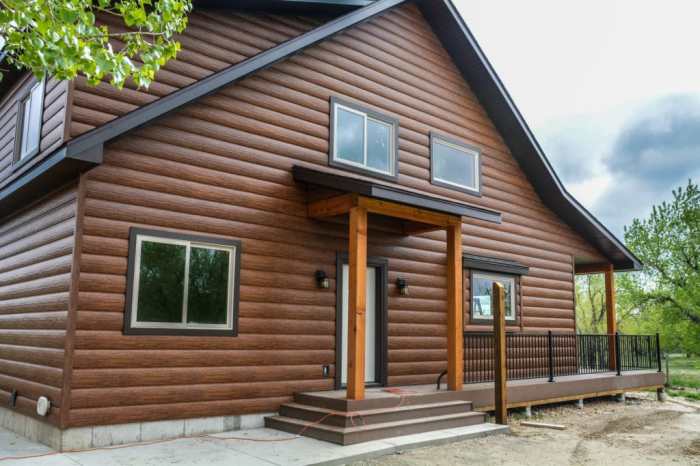Delve into the realm of metal siding for houses, where durability meets style and functionality. From the different types available to the installation process, this topic uncovers the beauty and benefits of choosing metal siding for your home.
As we navigate through the details, you'll discover the key aspects that make metal siding a popular choice among homeowners looking for a long-lasting and energy-efficient solution.
Types of Metal Siding

Metal siding is a popular choice for houses due to its durability, low maintenance, and modern aesthetic. There are several types of metal siding options available, each with its own characteristics and profiles.
Steel Siding
Steel siding is known for its strength and durability. It is resistant to dents and can withstand harsh weather conditions. Steel siding is available in a variety of colors and finishes, making it a versatile option for homeowners. Popular profiles include horizontal lap, vertical panels, and shingles.
Aluminum Siding
Aluminum siding is lightweight and corrosion-resistant. It is a popular choice for coastal areas or regions with high humidity. Aluminum siding is also available in a range of colors and profiles, including smooth panels, textured finishes, and wood-grain patterns.
Zinc Siding
Zinc siding is a durable and eco-friendly option for metal siding. It develops a natural patina over time, giving it a unique and weathered look. Zinc siding is low maintenance and has a long lifespan, making it a sustainable choice for homeowners looking for a distinctive finish.
Benefits of Metal Siding
Metal siding offers numerous advantages for houses, making it a popular choice among homeowners looking for a durable and efficient option.Metal siding is known for its exceptional durability and longevity. Unlike other materials like wood or vinyl, metal siding is resistant to rot, mold, and insect damage.
It can withstand harsh weather conditions, including heavy rain, snow, and strong winds, without deteriorating or needing frequent maintenance. This durability ensures that metal siding can last for decades, providing long-term protection for your home.
Energy Efficiency
Metal siding is also valued for its energy efficiency. With proper insulation, metal siding can help regulate indoor temperatures, reducing the need for heating and cooling systems. This can result in lower energy bills and a more environmentally friendly home.
Additionally, metal siding is recyclable and can be repurposed, making it a sustainable choice for homeowners looking to reduce their environmental impact.
Installation Process
Metal siding installation on a house involves several key steps to ensure a proper and durable finish. From preparing the surface to insulating and weatherproofing, each stage is crucial for a successful installation.
Preparation and Tools
Before starting the installation process, it is essential to gather the necessary tools and materials. Common tools required for metal siding installation include:
- Tape measure
- Tin snips
- Hammer
- Level
- Chalk line
In addition to tools, make sure to have the following materials on hand:
- Metal siding panels
- Screws or nails
- House wrap or insulation
- Caulk and sealant
Insulation and Weatherproofing
Proper insulation and weatherproofing are essential to protect your home from the elements and improve energy efficiency. Here are some common techniques to ensure insulation and weatherproofing during metal siding installation:
- Install house wrap or insulation material before attaching the metal siding panels to provide an extra layer of protection.
- Use caulk and sealant around windows, doors, and any gaps in the siding to prevent water infiltration and drafts.
- Consider adding a vapor barrier between the insulation and siding to further enhance moisture resistance.
- Ensure that the flashing around corners, edges, and rooflines is properly installed to prevent water damage.
Maintenance and Care

Metal siding is a durable and low-maintenance option for houses, but it still requires some care to prolong its lifespan and keep it looking its best.
Cleaning Methods
- Regularly wash metal siding with a mixture of mild soap and water to remove dirt, dust, and grime.
- For tougher stains, use a non-abrasive cleaner and a soft brush to scrub the affected areas gently.
- Rinse the siding thoroughly with clean water to remove all cleaning residue.
Frequency of Cleaning
It is recommended to clean metal siding at least once or twice a year to prevent dirt buildup and maintain its appearance.
Inspection and Maintenance
- Regularly inspect metal siding for signs of rust, corrosion, or damage.
- Look for loose or missing panels, chipped paint, or dents that may compromise the integrity of the siding.
- Address any issues promptly to prevent further damage and extend the lifespan of the metal siding.
Final Wrap-Up

In conclusion, metal siding offers a blend of aesthetics, durability, and sustainability that can transform any house into a modern masterpiece. With proper maintenance and care, your metal siding can stand the test of time while enhancing the overall appeal of your home.
Expert Answers
What are the key differences between steel, aluminum, and zinc metal siding?
Steel is known for its strength, aluminum for its lightweight properties, and zinc for its corrosion resistance. Each material offers unique characteristics to suit different needs.
How often should I clean my metal siding?
It's recommended to clean metal siding at least once a year to remove dirt and debris that can accumulate and affect its appearance.
What tools are essential for installing metal siding?
Tools such as a hammer, tin snips, level, and caulking gun are commonly used during metal siding installation to ensure a precise and secure fit.
When should I consider repairing or replacing metal siding?
If you notice significant damage like dents, rust, or loose panels, it's advisable to contact a professional for repairs or consider replacing the affected sections for the best results.










